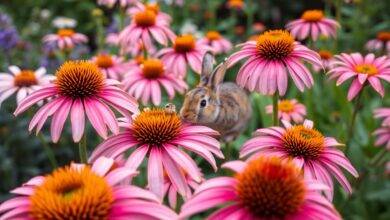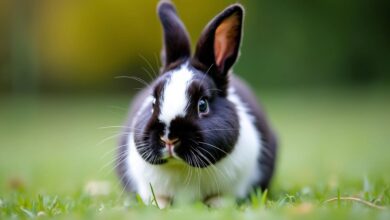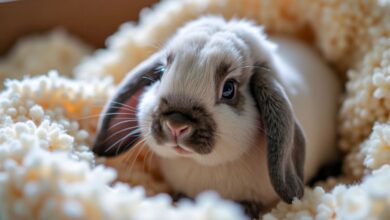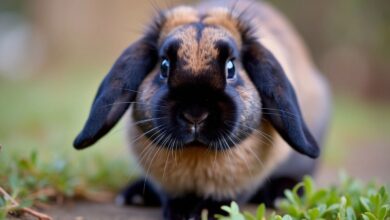Grey Holland Lop: Care, Features & Owner’s Guide
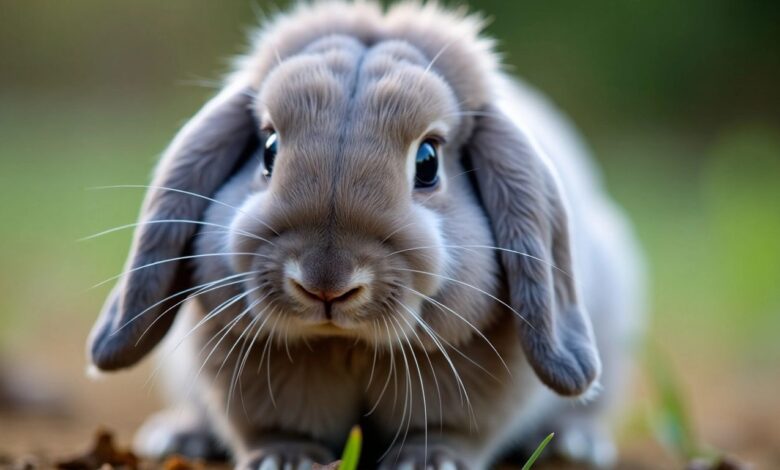
The Grey Holland Lop is a beloved breed known for its adorable looks and friendly personality. This guide covers everything you need to know about caring for these charming rabbits, from their appearance and behavior to their health and diet. Whether you’re a new owner or considering adopting one, this guide will help you understand the essentials for a happy and healthy Grey Holland Lop.
Key Takeaways
- Grey Holland Lops have a muscular build and short size, making them unique among rabbit breeds.
- These rabbits are friendly and calm, requiring regular playtime and chew toys to stay happy.
- Common health issues include dental problems, so regular check-ups and a proper diet are vital.
- Holland Lops have a rich history, first appearing in the UK in the 1970s before spreading globally.
- Providing a safe and engaging environment is crucial for their well-being, whether indoors or outdoors.
Ideal Appearance of Grey Holland Lop

Muscular Build and Size
The Grey Holland Lop is known for its compact and muscular build. They typically weigh between 2 to 4 pounds, with a maximum weight of 4 pounds according to show standards. Their body should have broad shoulders and deep hindquarters, which are essential traits for high-quality rabbits.
| Feature | Description |
|---|---|
| Weight | 2 – 4 pounds |
| Body Type | Muscular and compact |
| Ideal Height | Approximately 12 inches |
Distinctive Facial Features
One of the most recognizable aspects of the Grey Holland Lop is its short, rounded nose. This feature sets them apart from other lop breeds. Their ears are also unique, being almond-shaped and about 4.7 inches long.
Coat Colors and Patterns
The coat of a Grey Holland Lop can vary, but the grey color is often luminous and striking. Common patterns include solid, broken, and tortoise. Here are some popular colors:
- Grey
- Black
- Chocolate
- Lilac
The ideal appearance of a Grey Holland Lop combines a muscular body, distinctive facial features, and a beautiful coat, making them a favorite among rabbit enthusiasts.
Behavioral Traits of Grey Holland Lop

Calm and Friendly Nature
Grey Holland Lops are known for their gentle demeanor. They may seem shy at first, but with time, they become very affectionate. Owners often find that these rabbits enjoy spending time with people and can be quite social.
Exercise and Play Requirements
To keep your Grey Holland Lop happy and healthy, regular exercise is essential. Here are some key points to consider:
- Daily Playtime: Aim for at least 1-2 hours of play each day.
- Toys: Provide a variety of chew toys to keep them entertained and prevent boredom.
- Space: Ensure they have enough room to hop around freely.
Chewing Habits and Toys
Chewing is a natural behavior for rabbits. It helps keep their teeth healthy and prevents them from becoming too long. Here are some safe options:
- Wooden Chew Toys: These are great for gnawing and are safe for your rabbit.
- Cardboard Boxes: They love to chew and play with cardboard, which is also inexpensive.
- Hay: Not only is hay a part of their diet, but it also serves as a chewable item.
Remember, if your rabbit doesn’t have enough to chew on, they might start nibbling on furniture or other household items. Keeping them engaged is key to a happy home!
In summary, Grey Holland Lops are friendly and require regular interaction and playtime. Providing them with the right toys and space will ensure they thrive in your care.
Health and Wellness of Grey Holland Lop
Common Health Issues
Holland Lops are generally healthy, but they can face some common health problems. Here are a few to watch for:
- Ear infections: These can occur due to their floppy ears.
- Dental issues: Overgrown teeth can cause pain and eating problems.
- Parasites: Mites and fleas can affect their skin and fur.
Dietary Needs
A proper diet is crucial for your rabbit’s health. Here’s what you should include:
- 70% hay: Timothy hay is the best choice.
- Pellets: High-quality rabbit pellets should be given in moderation.
- Fresh veggies: Leafy greens like romaine lettuce are great.
| Food Type | Recommended Amount |
|---|---|
| Hay | Unlimited |
| Pellets | 1/4 cup per 5 lbs |
| Vegetables | 1 cup per 5 lbs |
Grooming and Dental Care
Regular grooming helps keep your rabbit healthy. Here are some tips:
- Brush weekly: This prevents fur ingestion and blockages.
- Trim nails monthly: Keep their nails short to avoid injury.
- Check teeth regularly: Look for overgrowth to prevent pain.
Keeping your rabbit healthy requires regular vet visits. Annual check-ups can cost between $75 and $200, ensuring your pet stays in good shape.
History and Origin of Grey Holland Lop

Development of the Breed
The Holland Lop was first created by a Dutch breeder named Adrian de Cock in the late 1940s. He wanted to combine the size of the French Lop with the smaller Netherland Dwarf. After several attempts, he successfully bred a rabbit that was just the right size. By 1964, these rabbits were recognized in Europe, paving the way for their popularity.
Introduction to the United States
In 1976, Holland Lops made their way to the United States. They were officially recognized by the American Rabbit Breeders Association (ARBA) in 1979. This recognition helped them gain popularity among rabbit lovers across the country.
Recognition by Rabbit Breeders Associations
Holland Lops are now one of the most popular breeds in both the United States and the United Kingdom. Their unique features and friendly nature have made them favorites among pet owners.
| Year | Event |
|---|---|
| 1949 | First breeding attempts by Adrian de Cock |
| 1964 | Recognition in Europe |
| 1976 | Arrival in the United States |
| 1979 | Recognition by ARBA |
The journey of the Holland Lop from a small breeding project to a beloved pet is a testament to the dedication of breeders and the charm of these rabbits.
Overall, the history of the Grey Holland Lop is a fascinating tale of breeding, recognition, and love for these adorable creatures.
Housing and Environment for Grey Holland Lop
Ideal Cage Size and Setup
To keep your Grey Holland Lop happy and healthy, the cage should be at least 18 inches by 25 inches. However, a larger space is always better. Here are some key points to consider:
- Avoid wire bottoms: They can hurt your rabbit’s feet.
- Provide hiding spots: This helps them feel safe.
- Include a litter box: This makes cleaning easier.
Outdoor vs. Indoor Living
Both indoor and outdoor living can work for your rabbit, but each has its pros and cons:
- Indoor Living:
- Safer from predators.
- Easier to monitor health and behavior.
- More interaction with family.
- Outdoor Living:
- More space to hop around.
- Natural sunlight and fresh air.
- Requires secure fencing to keep them safe.
Safety and Enrichment
Your rabbit needs a safe and stimulating environment. Here are some tips:
- Rabbit-proof your home: Remove hazards like electrical cords.
- Provide toys: Chew toys and tunnels keep them entertained.
- Supervised playtime: Let them explore outside their cage under supervision.
Keeping your rabbit’s environment safe and engaging is crucial for their well-being. Regularly check for hazards and provide plenty of enrichment to keep them happy!
Feeding Your Grey Holland Lop

Essential Diet Components
To keep your Grey Holland Lop healthy, it’s important to provide a balanced diet. A good diet consists of:
- 80% hay (like timothy hay)
- Grain-free pellets
- Fresh fruits and vegetables
Safe Fruits and Vegetables
When choosing fruits and vegetables, make sure they are safe for your rabbit. Here are some options:
- Carrots
- Leafy greens (like romaine lettuce)
- Apples (without seeds)
Importance of Fresh Water
Always provide your rabbit with fresh water. This is crucial for their health and helps with digestion.
A well-balanced diet is key to a happy and healthy Grey Holland Lop.
| Food Type | Recommended Amount | Notes |
|---|---|---|
| Hay | Unlimited | Essential for digestion |
| Pellets | 1/4 cup daily | Choose high-quality brands |
| Fruits & Veggies | 1/4 cup daily | Introduce slowly to avoid upset stomachs |
Feeding your Grey Holland Lop the right foods will help them thrive and stay active!
Breeding and Lifespan of Grey Holland Lop
Breeding Practices
Breeding Grey Holland Lops requires careful planning and knowledge. Here are some key points to consider:
- Choose Healthy Breeders: Always select rabbits that are healthy and have good temperaments.
- Understand Genetics: Familiarize yourself with the genetics of the breed to avoid health issues.
- Monitor Breeding Conditions: Ensure a safe and comfortable environment for the rabbits during breeding.
Average Lifespan
The average lifespan of a Grey Holland Lop is typically between 5 to 7 years. Factors that can influence their lifespan include:
- Diet: A balanced diet can lead to a longer, healthier life.
- Exercise: Regular playtime helps maintain their physical health.
- Veterinary Care: Routine check-ups can catch health issues early.
| Factor | Impact on Lifespan |
|---|---|
| Diet | Positive |
| Exercise | Positive |
| Veterinary Care | Positive |
Caring for Baby Lops
When caring for baby Grey Holland Lops, keep these tips in mind:
- Provide a Warm Environment: Newborns need warmth to thrive.
- Monitor Their Growth: Keep an eye on their weight and health.
- Socialize Early: Gentle handling helps them become friendly pets.
Caring for Grey Holland Lops requires dedication and love. Proper care ensures they live a happy and healthy life.
Final Thoughts on Caring for Your Grey Holland Lop
In conclusion, owning a Grey Holland Lop can be a rewarding experience. These rabbits are known for their friendly nature and unique looks. To keep them happy and healthy, it’s important to provide them with a proper diet, regular exercise, and plenty of love. Remember to groom them often and check their teeth to prevent any health issues. With the right care, your Holland Lop can be a wonderful companion for many years. Enjoy the journey of being a rabbit owner!
Frequently Asked Questions
What is the ideal weight for a Grey Holland Lop?
A Grey Holland Lop should ideally weigh between 2 to 4 pounds. The maximum weight allowed in shows is 4 pounds.
Are Grey Holland Lops friendly pets?
Yes, Grey Holland Lops are known for being calm and friendly. They enjoy spending time with their owners.
What should I feed my Grey Holland Lop?
Their diet should consist mainly of timothy hay, high-quality pellets, and a variety of fresh fruits and vegetables.
How often should I groom my Grey Holland Lop?
You should brush your Grey Holland Lop weekly to prevent fur ingestion and dental issues, especially during shedding season.
What is the average lifespan of a Grey Holland Lop?
Grey Holland Lops typically live around 5 to 7 years with proper care.
Do Grey Holland Lops require a lot of exercise?
Yes, they need regular exercise and playtime to stay healthy and happy.


